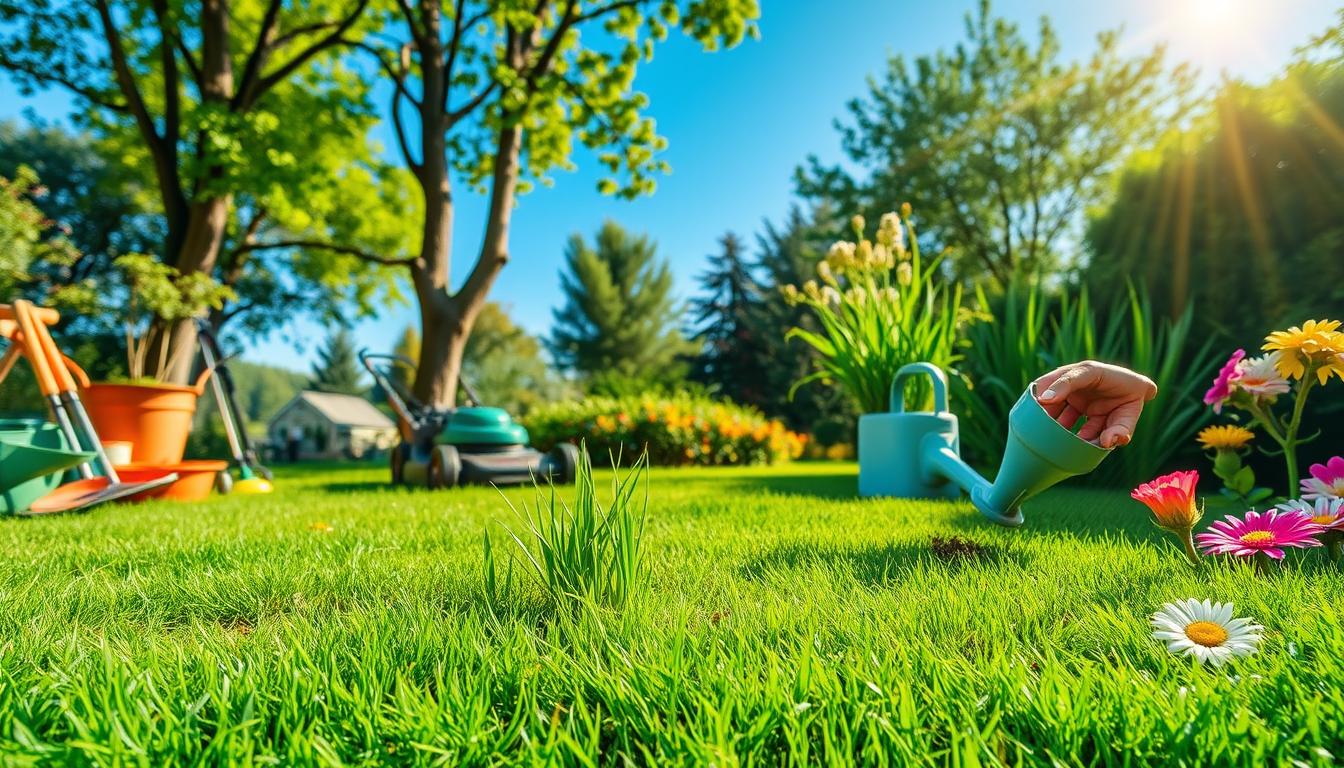Welcome to our comprehensive guide to lawn care. Here, we’ll cover everything you need to know to create a beautiful and healthy lawn. We’ll focus on proper lawn care techniques, various grass types, and effective lawn maintenance strategies.
Proper lawn care is crucial for a healthy and thriving lawn. It involves regular mowing, watering, and fertilizing. We’ll also discuss dealing with common lawn problems. These are essential aspects of lawn care, including tips for selecting the right grass types and implementing effective lawn maintenance routines.
Our goal is to provide you with a thorough understanding of lawn care. We aim to help you create a beautiful outdoor space that you can enjoy for years to come. By following our expert advice on lawn care, grass types, and lawn maintenance best practices, you’ll be well on your way.
Introduction to Lawn Care
In this guide, we’ll take you through the process of creating a perfect lawn. We’ll cover seeding to maintenance and provide valuable tips and techniques. You’ll learn how to deal with common lawn problems and select the right grass types for your climate and lawn care needs.
Key Takeaways
- Proper lawn care is essential for a healthy and thriving lawn
- Regular mowing, watering, and fertilizing are crucial aspects of lawn maintenance
- Selecting the right grass types is important for a beautiful and low-maintenance lawn
- Effective lawn maintenance strategies can help prevent common lawn problems
- Proper lawn care techniques can help create a beautiful outdoor space
- Lawn care involves a combination of seeding, maintenance, and upkeep
- Understanding lawn care basics is vital for a successful lawn care experience
Understanding Your Lawn’s Basic Needs
To ensure your lawn remains healthy and vibrant, it’s crucial to grasp its fundamental requirements. Effective lawn maintenance hinges on several critical aspects, including sunlight, water, and nutrients. By ensuring your lawn receives the appropriate amounts of these elements, you foster its strength and resilience.
A robust lawn begins with optimal soil health. This necessitates a soil composition rich in nutrients, essential for growth. Regular soil testing is vital to pinpoint any deficiencies, enabling you to refine your lawn maintenance strategies and enhance overall soil quality.
Sunlight Requirements
Typically, lawns thrive with at least six hours of direct sunlight daily. If your lawn falls short of this, you’ll need to tweak your lawn maintenance approach to compensate.
Water Needs
Lawns generally require one to two inches of water weekly, sourced from either rainfall or irrigation. Excessive watering can be detrimental, so it’s imperative to monitor soil moisture levels. Adjust your watering schedule as needed to preserve soil health.
Nutrient Requirements
Your lawn necessitates a balanced intake of nutrients to flourish. This includes nitrogen, phosphorus, and potassium. Utilizing fertilizers can supply these nutrients, but adherence to recommended application rates is crucial. This prevents lawn damage and maintains soil health.
By comprehending and fulfilling your lawn’s basic needs, you can cultivate a robust and healthy lawn. Prioritize lawn maintenance and soil health to ensure your lawn’s optimal condition.
Selecting the Right Grass Type for Your Climate
Choosing the right grass type is key to a beautiful and healthy lawn. Different grass types excel in various climates. The wrong choice can result in a lawn vulnerable to disease, pests, and weeds. It’s vital to consider temperature, rainfall, and sunlight when making your selection.
Kentucky bluegrass, perennial ryegrass, and tall fescue are among the most popular grass types. Each has its own strengths and weaknesses. For instance, Kentucky bluegrass boasts a dark green color and fine texture but needs regular watering and care. Perennial ryegrass, while more drought-resistant and low-maintenance, may not be as visually appealing.
- Kentucky bluegrass: dark green color, fine texture, requires frequent watering and maintenance
- Perennial ryegrass: drought-tolerant, requires less maintenance, may not be as aesthetically pleasing
- Tall fescue: deep-rooted, drought-tolerant, requires less maintenance
It’s crucial to pick the grass type that matches your climate and lifestyle. This ensures a lawn that’s both beautiful and low-maintenance.
| Grass Type | Climate | Maintenance |
|---|---|---|
| Kentucky Bluegrass | Cool | High |
| Perennial Ryegrass | Cool | Medium |
| Tall Fescue | Warm | Low |
Essential Soil Preparation Techniques
Soil health is vital for a lush lawn, and proper preparation is essential. Before planting or seeding, assessing the soil’s condition is crucial. This involves soil testing to determine the soil’s pH level, nutrient content, and structure.
A healthy soil pH balance is vital for lawn maintenance. Most grass types prefer a slightly acidic to neutral soil pH, ranging from 6.0 to 7.0. Adjusting the pH balance can be done through various methods, including adding lime to raise the pH or sulfur to lower it.
Soil Testing Methods
Soil testing can be done using DIY kits or by sending samples to a laboratory for analysis. These tests provide valuable information on the soil’s nutrient content, including nitrogen, phosphorus, and potassium levels. Based on the test results, soil amendment strategies can be developed to address any deficiencies or imbalances.
pH Balance Adjustment
Adjusting the soil’s pH balance is critical for maintaining soil health and promoting healthy lawn growth. This can be achieved through the use of organic or synthetic amendments, such as compost or fertilizers. It’s essential to follow the recommended application rates and timing to avoid over- or under-correcting the soil’s pH.
Soil Amendment Strategies
Soil amendment strategies involve adding organic matter, such as compost or manure, to improve the soil’s structure and fertility. This helps to support beneficial microorganisms, increase the soil’s water-holding capacity, and promote healthy root growth. By implementing these strategies, homeowners can create a fertile and well-draining soil environment that supports optimal lawn maintenance and soil health.
Professional Lawn Care Tips and Techniques
For a well-manicured lawn, regular lawn maintenance is crucial. This includes mowing, watering, and fertilizing. Proper mowing techniques, such as maintaining a sharp blade and mowing at the right height, can help prevent damage to the lawn.
A lawn care routine should also include regular watering and fertilization. It’s important to water deeply but infrequently to encourage deep root growth. Fertilize at the right time of year to promote healthy growth.
Some additional tips for lawn care include:
- Removing weeds and debris regularly
- Aerating the lawn to improve drainage and reduce soil compaction
- Using organic or chemical fertilizers to promote healthy growth
By following these lawn maintenance tips, you can keep your lawn looking its best. Always follow the specific needs of your lawn. If unsure about any aspect of lawn care, seek professional help.
Mastering the Art of Seeding
Seeding is a vital part of lawn care, and the right techniques can significantly impact your lawn’s health. To achieve a lush, green lawn, understanding timing, method, and post-seeding care is crucial. It involves choosing the right grass, preparing the soil, and ensuring proper care after seeding.
Timing is key in seeding techniques. The ideal time to seed varies by grass type and climate. Cool-season grasses do best in cooler temperatures, while warm-season grasses thrive in warmer weather. Knowing your grass’s specific needs helps determine the best seeding time.
There are several seeding methods, including broadcast seeding, slit seeding, and hydroseeding. Each has its pros and cons, depending on lawn size, grass type, and budget. Post-seeding care is also vital, ensuring soil moisture, weed control, and nutrient provision.
Key post-seeding care points include:
- Maintaining soil moisture
- Controlling weeds
- Providing adequate nutrients
- Mowing and pruning
By mastering seeding techniques, you can create a stunning lawn. Choose the right grass, prepare the soil well, and provide proper care after seeding. With the right approach, your lawn will flourish for years.
| Seeding Method | Advantages | Disadvantages |
|---|---|---|
| Broadcast Seeding | Easy to apply, covers large areas | May not provide even coverage |
| Slit Seeding | Provides even coverage, promotes healthy growth | More expensive, requires specialized equipment |
| Hydroseeding | Fast and efficient, promotes healthy growth | More expensive, requires specialized equipment |
Essential Tools for Lawn Maintenance
Having the right lawn tools is crucial for maintaining a healthy and beautiful lawn. A well-manicured lawn not only enhances the aesthetic appeal of your property but also increases its value. To achieve this, you’ll need a range of essential tools, including lawn mowers, trimmers, and other equipment.
Some of the must-have lawn tools include:
- Lawn mowers: for cutting grass to the desired height
- Trimmers: for edging and trimming around trees and gardens
- Pruning shears: for shaping and maintaining shrubs and plants
- Rakes: for removing leaves and debris from the lawn
When choosing lawn tools, consider the size of your lawn, the type of grass, and your personal preferences. It’s also essential to maintain your tools regularly to ensure they continue to function effectively.
By investing in the right lawn tools and using them properly, you’ll be able to keep your lawn looking its best. This will allow you to enjoy the many benefits that come with a well-maintained outdoor space.
| Tool | Purpose | Frequency of Use |
|---|---|---|
| Lawn Mower | Cutting grass | Weekly |
| Trimmer | Edging and trimming | Bi-Weekly |
| Pruning Shears | Shaping and maintaining shrubs | Monthly |
Seasonal Lawn Care Calendar
Regular lawn maintenance is key to keeping your lawn in top shape all year. A well-thought-out seasonal lawn care calendar ensures your lawn gets the right care at the right time. It’s vital for a healthy, lush lawn.
Here are some essential tasks for your seasonal lawn care calendar:
- Spring Care Guide: Clean up winter debris, apply fertilizers, and prune trees and shrubs to promote healthy growth and lawn maintenance.
- Summer Maintenance: Regularly mow and water your lawn, and apply pest control measures as needed to protect your grass care investment.
- Fall Preparation: Aerate your lawn, apply fall fertilizers, and plant new grass seeds to prepare your lawn for the next growing season.
- Winter Protection: Apply winterizers to protect your lawn from harsh winter conditions and prevent damage to your grass care efforts.
By adhering to a seasonal lawn care calendar and focusing on regular maintenance, you can ensure your lawn remains in excellent condition throughout the year.
| Season | Lawn Care Tasks |
|---|---|
| Spring | Clean up winter debris, apply fertilizers, prune trees and shrubs |
| Summer | Regularly mow and water, apply pest control measures |
| Fall | Aerate, apply fall fertilizers, plant new grass seeds |
| Winter | Apply winterizers, protect from harsh winter conditions |
Effective Weed Control Strategies
Weed control is vital for lawn health and appearance. Understanding common weeds and control methods is key. This knowledge helps in creating an effective weed control plan.
Lawns often face dandelions, clover, and crabgrass. These can be managed with natural and chemical approaches. Natural methods include pulling weeds, using mulch, and planting competitive grasses.
Common Weed Identification
Identifying weeds is crucial for effective control. Weeds often have broad leaves, tall stalks, and vibrant colors. Knowing your weeds helps in choosing the right control method.
Natural Weed Control Methods
Natural methods are ideal for those avoiding chemical herbicides. Boiling water, vinegar, and cornmeal are effective. These methods are eco-friendly, cost-effective, and simple to use.
Integrating these natural methods into your lawn care can manage weeds well. Regular monitoring and adjusting your strategy are essential for the best results.
Dealing with Common Lawn Problems
Every lawn will face issues at some point. Knowing how to tackle these problems is key to a healthy, beautiful lawn. Lawn care and maintenance are vital in preventing and solving these issues. Common problems include pests, diseases, and nutrient deficiencies.
Proper lawn care and maintenance can prevent and solve these issues. Regular watering and mowing can ward off pests and diseases. Fertilization and soil testing help identify and fix nutrient deficiencies.
Here are some tips for tackling common lawn problems:
- Regularly check your lawn for pests, diseases, and nutrient deficiencies
- Use natural and organic methods to solve problems whenever possible
- Keep your lawn well-watered and mowed to prevent pests and diseases
- Test your soil regularly to identify and address nutrient deficiencies
By following these tips and practicing good lawn care and maintenance, you can prevent and solve common lawn problems. This will keep your lawn healthy and beautiful.
Water Management and Conservation
Effective water management is key to a lush, healthy lawn. It’s vital to find the right balance in watering. Too little water can harm your lawn, while too much is wasteful and damaging.
Investing in irrigation systems that can be programmed is a smart move. These systems ensure your lawn gets the right amount of water at the right time. This approach helps prevent waste and keeps your lawn in top condition.
Irrigation Systems
Choose irrigation systems that prioritize water conservation. Look for features like rain sensors and moisture meters. These tools adjust watering schedules based on weather and soil moisture.
Watering Schedules
Creating a watering schedule is crucial for lawn maintenance. Water deeply but less often to promote strong root growth. Shallow, frequent watering weakens your lawn’s roots.
Drought Management
In drought-prone areas, a drought management plan is essential. This plan might include watering less often, choosing drought-resistant grass, and using water-saving irrigation systems.
| Watering Tip | Benefits |
|---|---|
| Water deeply but infrequently | Encourages deep root growth, makes lawn more drought-resistant |
| Use efficient irrigation systems | Reduces water waste, saves money on water bills |
| Implement drought management plan | Helps lawn survive drought conditions, reduces water consumption |
By adopting these water management strategies, you can significantly cut down on water use. This not only saves money but also ensures your lawn remains healthy and vibrant. It’s all about effective lawn maintenance.
Conclusion: Creating Your Perfect Lawn
Creating a lush, healthy lawn is a journey that requires knowledge, effort, and patience. Understanding your lawn’s needs, choosing the right grass, and mastering lawn care techniques are essential. These steps will help you create the perfect outdoor space you’ve always wanted.
Regular lawn care and maintenance are vital for your grass care success. Proper mowing, watering, weed control, and seasonal care are all crucial. With the right tools and dedication, your outdoor space can become a lush sanctuary for years.
Creating your perfect lawn is a continuous journey. With the knowledge from this guide, you’re ready to achieve lawn-care success. Embrace the process, try new techniques, and seek professional help when needed. A proactive approach to lawn care and grass care will help you enjoy your dream lawn.


